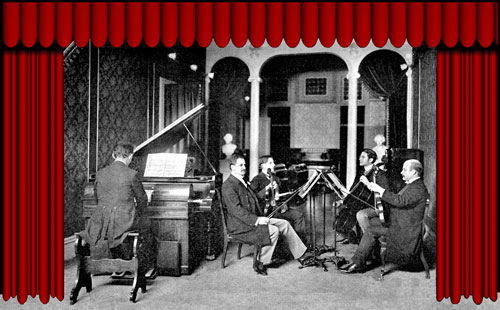
The First Major Pianola Concert - Mendelssohn Hall, New York, 15 November 1899.
Introduction
Concert-hall performances with keyboardless instruments date back well into the nineteenth century, as witness the jingoistic fantasia which Beethoven wrote for the
Panharmonicon, entitled "Wellington's Victory." Even if this composition proved too complex for the early orchestrions of the time, at least the intention was there! Concerts
with music rolls rather than pinned barrels seem generally to have been more reliable, and in the mid-1890s the Aeolian Company began to present public recitals, initially
with the Aeolian, a 58-note reed organ after which the Company was named, and subsequently with the Aeolian Pipe Organ and the Pianola.
Pianola concerts began in 1898 at the Company's warerooms at 18 West 23rd Street in New York, and by November of the following year they had spread to Mendelssohn Hall, home of the City's best-known Glee Club. The concert depicted above featured the Kaltenborn Quartet and two "pianolists," a new breed of musician who played the pianola artistically, on this occasion Francis L. Young, who went on to invent the Metrostyle, and Charles C. Parkyn, whose back is probably seen in the photograph. In view of the various instruments dotted around the back of the music room, the scene is probably a rehearsal for the main event, no doubt held at West 23rd Street.
The Need for Pianolists
The Aeolian Company had something of a dilemma on its hands. It needed to sell its Pianolas to as many people as possible, so it was in its interest to suggest how
easy the instrument was to play, at least as far as the notes were concerned. But on the other hand it wanted its concerts to be musically enjoyable, and to include professional
singers and instrumental soloists who would value the experience, and thereby provide useful testimonials, so it had to employ trained musicians to bring the Pianola to
life in a properly musical way. In an age when musical sentiment was paramount, there would have been no point in parading a soullessly note-perfect automaton in front of the
music-loving public.
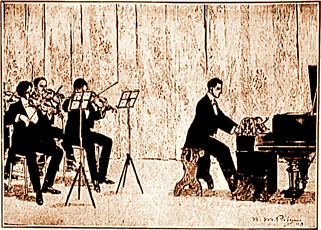
An Early Pianola Concert - Choralion Company advertisement, Dresden, November 1909.
Charles Parkyn, who may be found on our Pianolists page, and who is seen at the top of this page in rehearsal, was evidently a fine musician. A professional cellist from Boston, he joined the Aeolian Company in late 1899, to take charge of the Company's burgeoning concert series. The following summer he was playing the Pianola in Pittsburgh, accompanying the concertmaster of the newly founded Pittsburgh Orchestra, Luigi von Kunits, and performing piano duos with the doyen of local Pittsburgh musicians, Joseph Gittings. The reviewer in the Pittsburgh Times illuminated the elusively dual nature of the Pianola as follows:
"It is well-known how beautifully the Pianola will render the most difficult piano-music, even under the hands of an unskilled and uncultivated person; but Mr. Parkyn's performances showed that there are practically no limitations to the magnificent effects to be produced by the Pianola. In fact it lends itself immediately and sensibly to the sentiment and skill of the most accomplished and exacting musician."
A Decade and a Half of Showroom Recitals
The Aeolian Company was not the only manufacturer of player pianos to organise concerts at its showrooms, but it was the most successful, and in the early years it presented
so many recitals that the repertoire it chose can be sensibly listed and analysed.
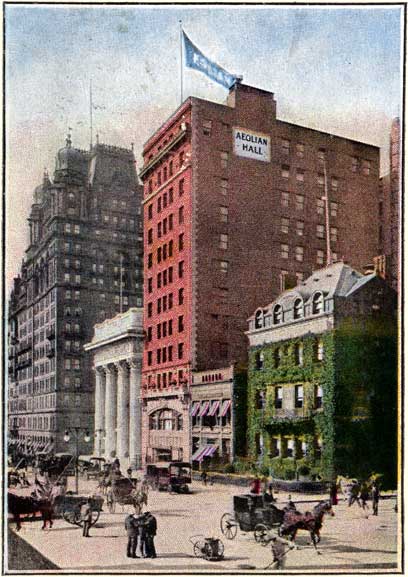
Aeolian Hall, New York (1902-1912) - 362 Fifth Avenue.
Aeolian in New York tended to locate its headquarters near the main two-way thoroughfares. From 1878 until 1927 it resided successively in East 14th Street, Broadway, Fifth Avenue around the corner from East 34th Street, and finally in West 42nd Street. Not only were these premises prominent and easy to reach by public and private transport, but they followed the purveyors of serious opera, as they too moved uptown, from the Academy of Music on East 14th, to the Metropolitan Opera on Broadway and West 39th. The Pianola and the Opera were never very far from each other, and it is not so surprising that many of Aeolian's Pianola concerts featured singers from the Met, often those at the outset of their careers, but every now and then including the stars of the current season.
Pianola Concertos with Orchestra
However, the repertoire of the Pianola was not limited to solo or chamber music, and it was not long before the instrument and its players appeared as soloists in concerto
performances with orchestra, though curiously enough not in North America, where the earliest concerto solo rolls were actually made. Since our modern world has tended to belittle the Pianola as a
musical instrument, we shall seek to place on record the circumstances and the personnel of these concerts.
The laurels for the very first Pianola concerto seem to lie with Mr J.T. White, of Barnstaple, in the English county of Devon, who played the Mendelssohn G minor Concerto on 16th January 1902, at the Alexandra Hall in Ilfracombe, accompanied by an orchestra of fifty players, conducted by Dr J.T. Gardner. The North Devon Journal reported that:
"The novelty of the pianola was doubtless the paramount attraction on Thursday evening, and proved the truth of all statements to the effect that music performed by it equals the work of the finest professional pianist. The G minor Concerto with its brilliant first movement, exquisite Andante, and Presto finale, went with a swing and vigour that won rapturous plaudits."
Londoners had to wait a further two years for a similar performance at the St James' Hall in Piccadilly, on 11th March 1904, given on the Triumph piano-player by F. Sydney Smith, with Messrs Ashton's Concert Orchestra, conducted by Arrigo Bocchi, a well-known musician of the time who went on to become the managing director of the newly built Philharmonic Hall in London's Great Portland Street. Perhaps the rolls were from the same stable - nos. 60 and 61 from the Aeolian Company's selection of accompaniment and special rolls - and they would most certainly have been restricted to the 65-note compass at this early stage. Young Mr Smith can be seen playing the Triumph in the photograph below, and it may also be noted that Maximilian Kastner, the owner of the firm which sold the American "Pianista" player in Europe under the name of the "Triumph", can be seen in the background.
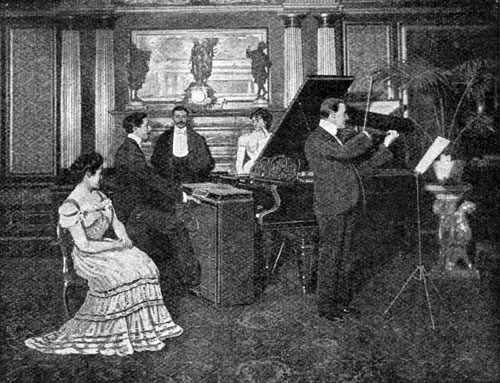
F. Sydney Smith at the Triumph Piano-Player - M. Kastner & Co, 302 Regent Street, London, March 1904.
From London the torch passed to Madrid, where on 5th November 1906, Vicente Toledo played both the Fourth Concerto by Anton Rubinstein and the Hungarian Fantasie by Franz Liszt, at the Teatro de la Princesa, accompanied by what was described as an orchestra of 45 professors, conducted by Don Arturo Saco del Valle. Luckily for us, the magazine, "El Teatro", sent along its photographer, so Señor Toledo and his "Pianola Metroestilo" were preserved for posterity and are reproduced below.
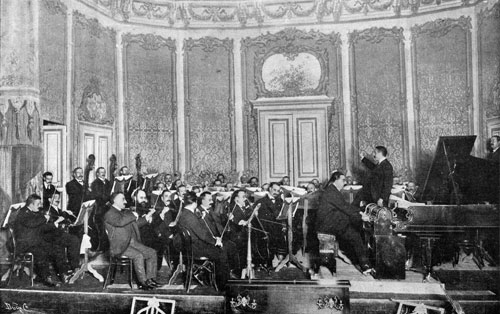
Vicente Toledo in rehearsal - Teatro de la Princesa, Madrid, 5 November 1906.
Photographers were not always so felicitously deployed, and the mammoth Pianola concerto performance that ensued at the Moscow Conservatoire in early 1908 had to be drawn by an imaginative New York artist, for an Aeolian Company advertisement. We have taken the liberty of placing the imaginary orchestra in the real surroundings, albeit without the audience of 3,000, which, the Moscow Zeitung reports, "greeted all renditions with an ever growing applause." The renowned Russian stamina must have sustained their enthusiasm, since they had to sit through both the Grieg and Hummel Concertos in A minor, plus a concerto by Anton Rubinstein, presumably the Fourth, as played in Madrid eighteen months before. By 1908 the Themodist had been added to the Metrostyle Pianola, and the reviewer noted that "every single melody tone, whether in the treble or bass, is given exactly the desired accent."
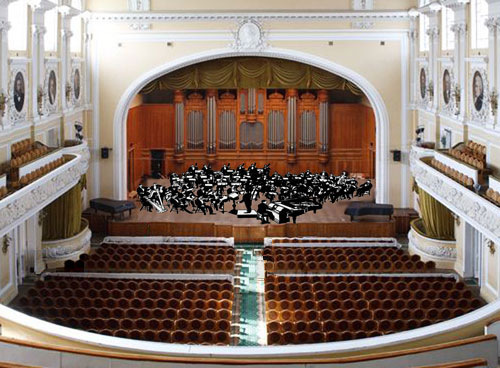
An imaginary view of the Pianola concert at the Moscow Conservatoire, Moscow, early 1908.
Thus far there are no details of the Moscow orchestra, conductor or Pianola soloist, though the latter must have been reasonably adept, and certainly tireless. One possible candidate might have been Hermann Schaad, an Aeolian Company demonstrator who later became Artists' Manager for the Duo-Art reproducing piano, and who, on 11th November 1905, played the Pianola at St Petersburg, to an audience consisting of Rimsky-Korsakow, Balakirew, Glazounow and Liapounow (to use Mr Schaad's spellings), surely one of the finest groups of listeners one could wish for!
A few months beforehand, on 28th November 1907, Rafael de Aceves, a fashionable Spanish composer who had taken over as the main French Pianolist, after Vicente Toledo had settled in Madrid, performed the Mendelssohn G minor Concerto and the Weber Concertstück, at the Salle Fémina in Paris, with the Orchestre Sechiari, conducted by its founder, the eminent violinist, Pierre Sechiari. M. Sechiari also exchanged the conductor's baton for the violinist's bow and played the Romance from the Second Violin Concerto by Wieniawski, accompanied "avec légèreté et nuances" by the Themodist Pianola and its rather well-known player.
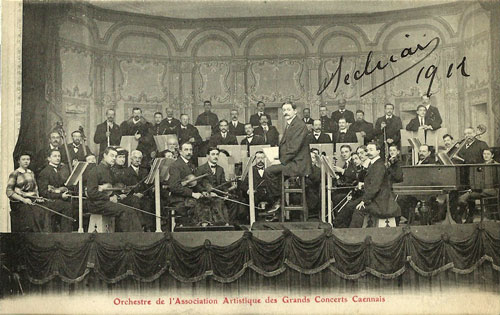
Pierre Sechiari conducting the Orchestre of Caen, Normandy, in about 1912.
According to the newspaper, l'Indicateur de Bayeux, a similar concert took place in Caen, Normandy, on 21st March 1909, with another of Pierre Sechiari's orchestras, the Orchestre de l'Association Artistique des Grands Concerts Caennais, whose title takes almost as long to recite as the music must have taken to play. On this occasion though, Sechiari gave way to another French violinist, Paul Viardot, who conducted the Rubinstein Fourth Concerto, seemingly with Rafael de Aceves once again appearing as soloist.
This mainly Anglo-French tradition of Pianola concertos reached its zenith in the years and even months preceding the First World War, at a time when the commercial success of the foot-pedalled Pianola and its rolls was at a level that it never again equalled during the decade of the 1920s. The most widely publicised concerto in the history of the Pianola took place in London, on 14th June 1912, at the famous Queen's Hall in Upper Regent Street. The London Symphony Orchestra gave an invitation concert, conducted by Artur Nikisch, the Hungarian musician who had recently taken over as the orchestra's principal conductor. The concert was sponsored and presented by the Orchestrelle Company, as the Aeolian Company's British organisation was known at that time, and advertisements appeared in many of the London newspapers, including the Times.
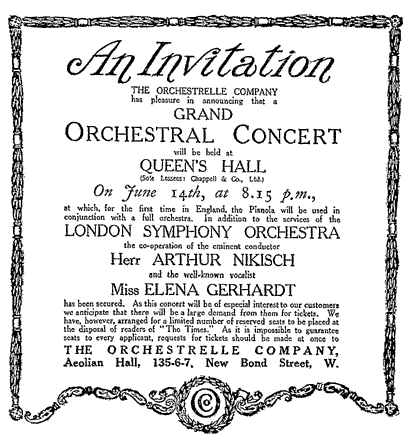
Concert Advertisement in the Times Newspaper, London, 12 June 1912
Elena Gerhardt, one of the leading sopranos of the age, was engaged to sing to the Pianola's accompaniment, but pride of place was taken by a performance of the Grieg Piano Concerto, with Easthope Martin, chief Pianola demonstrator of the Orchestrelle Company, as the solo Pianolist. Mr Martin also played the Liszt Hungarian Fantasia with the orchestra, plus a number of solo pieces, and he was congratulated afterwards by no less a personage than Paderewski, the owner of two Pianolas, and one of the many international musical figures attending the concert.
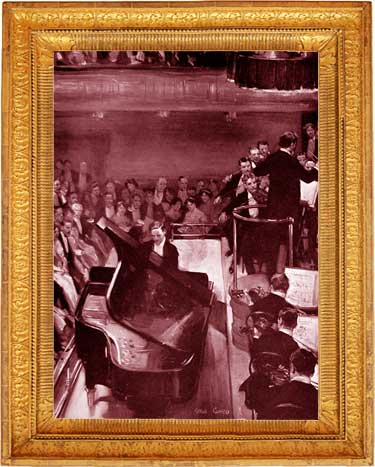
The Pianola and the London Symphony Orchestra, Queen's Hall, 14 June 1912.
The Aeolian Company's Gallic contingent was not long in responding! On 22nd February, 1913, Henri Dubois of the Paris headquarters performed the Grieg Concerto at the Théâtre de l'Apollo in Toulouse, with the Orchestre de l'Association Symphonique, "renforcé pour la circonstance," and he also accompanied the cellist, Marcel Ringeisen, best-known as the teacher of Andre Navarra, in a Beethoven cello sonata. As with many such occasions, the Aeolian Company went to some pains to avoid mentioning the name of the Pianola soloist, no doubt with the message that "anyone can play it" in the back of their minds, but the local press understood the reality of the situation, and l'Express du Midi noted that "the interpretation of the Grieg Concerto in A minor was that of an artist, a great artist. M. Dubois is just such a man, and by no means one of the least." He can be seen below, in morning dress, presenting an informal recital with a Duo-Art grand piano, to the assembled professors of the Paris Conservatoire in late 1921.
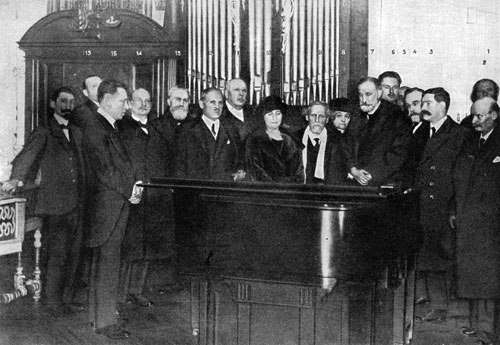
Henri Dubois presenting the Duo-Art at the Paris Conservatoire, 25 November 1921.
The main French Pianola concert followed towards the end of 1913, on 5th November at the Théâtre des Champs-Élysées in Paris, with the Lamoureux Orchestra conducted by Camille Chévillard, and Rafael de Aceves once again in the driver's seat. The programme was clearly based on what Aeolian felt to be a successful formula, wth the same concerto pieces that Easthope Martin had played in London, but with Marthe Chénal, of the Opéra-Comique, as the soprano soloist, in place of Elena Gerhardt
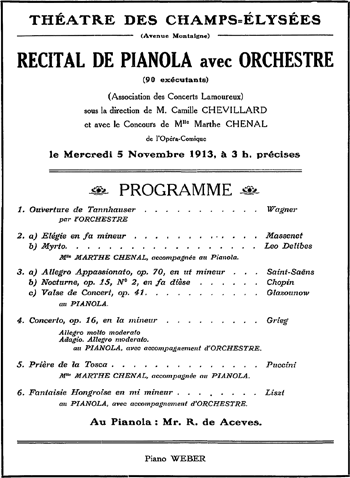
Concert Programme re-printed in Revue Musicale, Paris, 1 December 1913.
One detail that stands out from the photograph below is the name "WEBER" on the front of the concert grand piano, not only a reminder that the Aeolian Company's full title in the United States was "The Aeolian, Weber Piano and Pianola Company", but also a sign of the aggressive competition amongst piano manufacturers, in the days when a much greater variety of keyboard instruments was to be found on the world's concert platforms. The theatre had only opened a few months before, and it had already taken its place in musical history, with the première of the Rite of Spring occurring at the end of May.
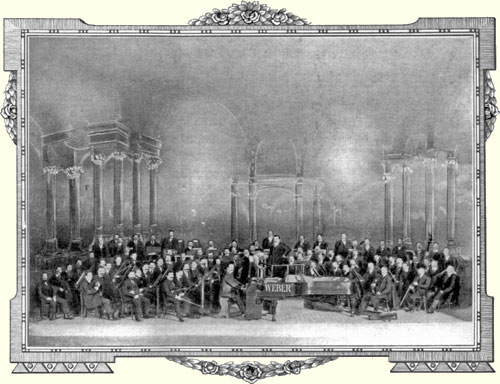
The Pianola at the Théâtre des Champs-Élysées, Paris, 5 November 1913.
M. de Aceves repeated his success two months later, on 1st January 1914, at the Concerts Classiques in Marseille, but later that year the War intervened, effectively putting an end to the initial era of the foot-pedalled Pianola as a concerto instrument. A final French concerto seems to have taken place on 22nd April 1923, when Léon Coupleux performed the Grieg with the Société des Concerts Symphoniques at Amiens, appropriately enough the location of the battle that became the turning point towards the final Allied victory.
Since 1920 there have been other concertos with Pianola and similar instruments, perhaps more numerous than most readers will realise; on 2nd November 1922, Harry Ellingham performed the Grieg Concerto at the Assembly Rooms in Tamworth, Staffordshire, with the newly-formed City of Birmingham Orchestra and its first conductor, Appleby Matthews, an experience repeated by the same orchestra some sixty-five years later, when Rex Lawson and Denis Hall, of the Pianola Institute, played Saint-Saëns' Carnival of Animals at the Last Night of the CBSO Proms at the Town Hall in Birmingham, impeccably conducted by Barry Wordsworth, now Music Director of the Royal Ballet.
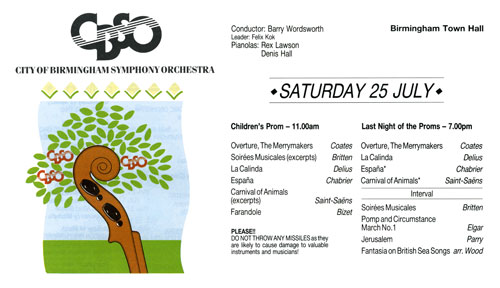
Two Pianolas with the City of Birmingham Symphony Orchestra, Town Hall, 25 July 1987.
In July 1929, Reginald Reynolds, chief British Duo-Art producer, played the first movement of the Schumann Concerto with the Wimbledon Festival Orchestra, and in 1930, William Candy, at one time Music Roll Reviewer for Gramophone and the Musical Times, played the Grieg with the Insurance Orchestra at the Scala Theatre in London. The list of such events since the Second World War is too great for this webpage, and there have been at least three recent concertos written especially for the "superhuman" capabilities of the Pianola, which have become especially important for present-day musicians, and these may all be written up one day, perhaps on one of our pages devoted to contemporary performance.